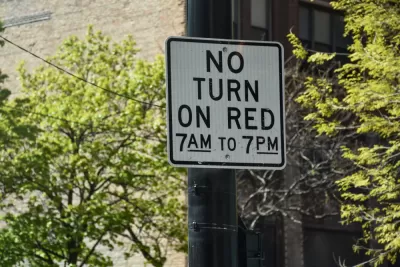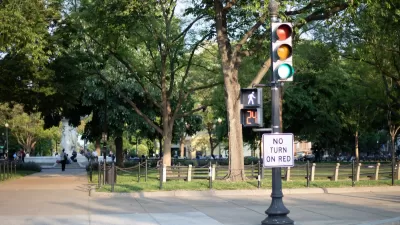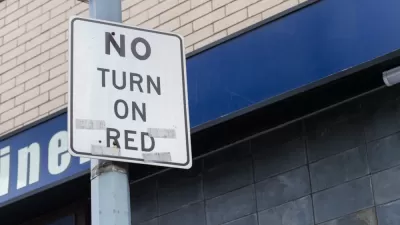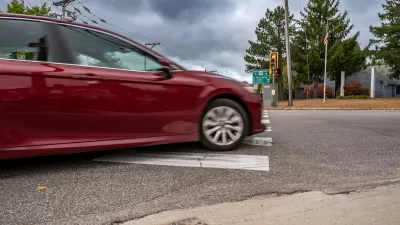Taking a second look at the widespread, but dangerous, practice.

Turning right on a red light may seem like an age-old tradition, but as Erika Bolstad explains in Stateline, the practice was primarily motivated by the oil embargo of the 1970s, when it was seen as a conservation measure. But as traffic fatalities continue to rise year after year, policymakers are taking a hard look at the practice and reconsidering its benefits and drawbacks.
Some states and cities are ending the practice: “Washington, D.C., will end most right-on-red turns by 2025. Already, the state of Hawaii has prohibited them on a tourist-dense stretch of road in Honolulu. The city of Berkeley in California is considering banning right on red at all intersections. Near the University of Michigan in Ann Arbor, the city last fall banned right turns at 50 signalized intersections in its downtown core.”
While rigorous studies about right turns on red remain scarce, “the studies that are emerging are beginning to show that limiting the practice can reduce crashes and close calls, and that drivers accommodate to the prohibition.” In one example, “A study by the District Department of Transportation in Washington, D.C., found that when the city banned right on red at 100 intersections in 2018, most drivers complied and there were fewer conflicts between pedestrians and vehicles.”
FULL STORY: States Consider Ending Right on Red to Address Rising Pedestrian Deaths

Alabama: Trump Terminates Settlements for Black Communities Harmed By Raw Sewage
Trump deemed the landmark civil rights agreement “illegal DEI and environmental justice policy.”

Study: Maui’s Plan to Convert Vacation Rentals to Long-Term Housing Could Cause Nearly $1 Billion Economic Loss
The plan would reduce visitor accommodation by 25% resulting in 1,900 jobs lost.

Planetizen Federal Action Tracker
A weekly monitor of how Trump’s orders and actions are impacting planners and planning in America.

Waymo Gets Permission to Map SF’s Market Street
If allowed to operate on the traffic-restricted street, Waymo’s autonomous taxis would have a leg up over ride-hailing competitors — and counter the city’s efforts to grow bike and pedestrian on the thoroughfare.

Parklet Symposium Highlights the Success of Shared Spaces
Parklets got a boost during the Covid-19 pandemic, when the concept was translated to outdoor dining programs that offered restaurants a lifeline during the shutdown.

Federal Homelessness Agency Places Entire Staff on Leave
The U.S. Interagency Council on Homelessness is the only federal agency dedicated to preventing and ending homelessness.
Urban Design for Planners 1: Software Tools
This six-course series explores essential urban design concepts using open source software and equips planners with the tools they need to participate fully in the urban design process.
Planning for Universal Design
Learn the tools for implementing Universal Design in planning regulations.
Caltrans
Smith Gee Studio
Institute for Housing and Urban Development Studies (IHS)
City of Grandview
Harvard GSD Executive Education
Toledo-Lucas County Plan Commissions
Salt Lake City
NYU Wagner Graduate School of Public Service





























